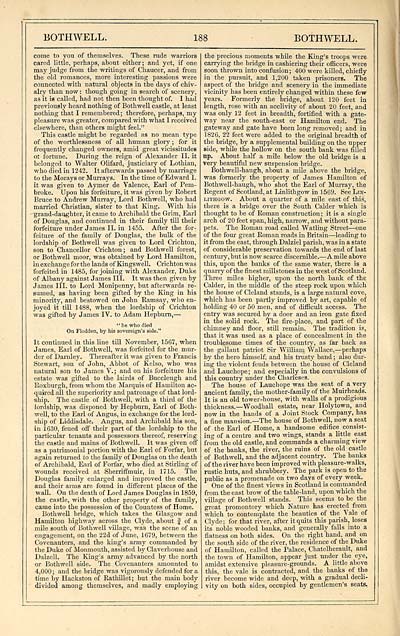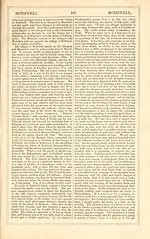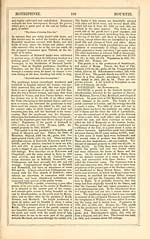Download files
Complete book:
Individual page:
Thumbnail gallery: Grid view | List view

BOTHWELL.
188
BOTHWELL.
come to you of themselves. These rude warriors
cared little, perhaps, about either; and yet, if one
may judge from the writings of Chaucer, and from
the old romances, more interesting passions were
connected with natural objects in the days of chiv-
alry than now : though going in search of scenery,
as it is called, had not then been thought of. I had
previously heard nothing of Bothwell castle, at least
nothing that I remembered; therefore, perhaps, my
pleasure was greater, compared with what I received
elsewhere, than others might feel."
This castle might be regarded as no mean type
of the worthlessness of all human glory ; for it
frequently changed owners, amid great vicissitudes
o£ fortune. During the reign of Alexander II. it
belonged to Walter Olifard, justiciary of Lothian,
who died in 1242. It afterwards passed by marriage
to the Morays or Murrays. In the time of Edward I.
it was given to Aymer de Valence, Earl of Pem-
broke. Upon his forfeiture, it was given by Robert
Bruce to Andrew Murray, Lord Bothwell, who had
married Christian, sister to that King. With his
-grand-daughter, it came to Archibald the Grim, Earl
of Douglas, and continued in their family till their
forfeiture under James II. in 1455. After the for-
feiture of the family Of Douglas, the bulk of the
lordship of Bothwell was given to Lord Crichton,
son to Chancellor Crichton; and Bothwell forest,
or Bothwell moor, was obtained by Lord Hamilton,
in exchange for the lands of Kingswell. Crichton was
forfeited in 1485, for joining with Alexander, Duke
of Albany against James III. It was then given by
James III. to Lord Monipenny, but afterwards re-
sumed, as having been gifted by the King in his
minority, and bestowed on John Ramsay, who en-
joyed it till 1488, when the lordship of Crichton
was gifted by James IV. to Adam Hepburn, —
"he who died
On Flodden, by his sovereign's side."
It continued in this line till November, 1567, when
James, Earl of Bothwell, was forfeited for the mur-
der of Darnley. Thereafter it was given to Francis
Stewart, son of John, Abbot of Kelso, who was
natural son to James V. ; and on his forfeiture his
estate was gifted to the lairds of Buccleugh and
Roxburgh, from whom the Marquis of Hamilton ac-
quired all the superiority and patronage of that lord-
ship. The castle of Bothwell, with a third of the
lordship, was disponed by Hepburn, Earl of Both-
well, to the Earl of Angus, in exchange for the lord-
ship of Liddisdale. Angus, and Archibald his son,
in 1630, feued off their part of the lordship to the
particular tenants and possessors thereof, reserving
the castle and mains of Bothwell. It was given off
as a patrimonial portion with the Earl of Forfar, but
again returned to the family of Douglas on the death
of Archibald, Earl of Forfar, who died at Stirling of
wounds received at Sherriffmuir, in 1715. The
Douglas family enlarged and improved the castle,
and their arms are found in different places of the
wall. On the death of Lord James Douglas in 1859,
the castle, with the other property of the family,
came into the possession of the Countess of Home.
Bothwell bridge, which takes the Glasgow and
Hamilton highway across the Clyde, about J of a
mile south of Bothwell village, was the scene of an
engagement, on the 22d of June, 1679, between the
Covenanters, and the king's army commanded by
the Duke of Monmouth, assisted by Claverhouse and
Dalzell. The King's army advanced by the north
or Bothwell side. The Covenanters amounted to
4,000 ; and the bridge was vigorously defended for a
time by Hackston of Rathillet; but the main body
divided among themselves, and madly employing
the precious moments while the King's troops were
carrying the bridge in cashiering their officers, were
soon thrown into confusion; 400 were killed, chiefly
in the pursuit, and 1,200 taken prisoners. The
aspect of the bridge and scenery in the immediate
vicinity has been entirely changed within these few
years. Formerly the bridge, about 120 feet in
length, rose with an acclivity of about 20 feet, and
was only 12 feet in breadth, fortified with a gate-
way near the south-east or Hamilton end. The
gateway and gate have been long removed ; and in
1826, 22 feet were added to the original breadth of
the bridge, by a supplemental building on the upper
side, while the hollowon the south bank was filled
up. About half a mile below the old bridge is a
very beautiful new suspension bridge.
Bothwell-haugh, about a mile above the bridge,
was formerly the property of James Hamilton of
Bothwell-haugh, who shot the Earl of Murray, the
Regent of Scotland, at Linlithgow in 1569. See Lin-
lithgow. About a quarter of a mile east of this,
there is a bridge over the South Calder which is
thought to be of Roman construction ; it is a single
arch of 20 feet span, high, narrow, and without para-
pets. The Roman road called Watling Street — one
of the four great Roman roads in Britain — leading to
it from the east, through Dalziel parish, was in a state
of considerable preservation towards the end of last
century, but is now scarce discernible. — A mile above
this, upon the banks of the same water, there is a
quarry of the finest millstones in the west of Scotland.
Three miles higher, upon the north bank of the
Calder, in the middle of the steep rock upon which
the house of Cleland stands, is a large natural cove,
which has been partly improved by art, capable of
holding 40 or 50 men, and of difficult access. The
entry was secured by a door and an iron gate fixed
in the solid rock. The fire-place, and part of the
chimney and floor, still remain. The tradition is,
that it was used as a place of concealment in the
troublesome times of the country, as far back as
the gallant patriot Sir William Wallace, — perhaps
by the hero himself, and his trusty band ; also dur-
ing the violent feuds between the house of Cleland
and Lauchope; and especially in the convulsions of
this country under the Charleses.
The house of Lauchope was the seat of a very
ancient family, the mother-family of the Muirheads.
It is an old tower-house, with walls of a prodigious
thickness.— Woodhall estate, near Holytown, and
now in the hands of a Joint Stock Company, has
a fine mansion.— The house of Bothwell, now a seat
of the Earl of Home, a handsome edifice consist-
ing of a centre and two wings, stands a little east
from the old castle, and commands a charming view
of the banks, the river, the ruins of the old castle
of Bothwell, and the adjacent country. The banks
of the river have been improved with pleasure- walks,
rustic huts, and shrubbery. The park is open to the
public as a promenade on two days of every week.
One of the finest views in Scotland is commanded
from the east brow of the table-land, upon which the
village of Bothwell stands. This seems to be the
great promontory which Nature has erected from
which to contemplate the beauties of the Vale of
Clyde; for that river, after it quits this parish, loses
its noble wooded banks, and generally falls into a
flatness on both sides. On the right hand, and on
the south side of the river, the residence of the Duke
of Hamilton, called the Palace, Chatelherault, and
the town of Hamilton, appear just under the eye,
amidst extensive pleasure-grounds. A little above
this, the vale is contracted, and the banks of the
river become wide and deep, with a gradual decli-
vity on both sides, occupied by gentlemen's seats,
188
BOTHWELL.
come to you of themselves. These rude warriors
cared little, perhaps, about either; and yet, if one
may judge from the writings of Chaucer, and from
the old romances, more interesting passions were
connected with natural objects in the days of chiv-
alry than now : though going in search of scenery,
as it is called, had not then been thought of. I had
previously heard nothing of Bothwell castle, at least
nothing that I remembered; therefore, perhaps, my
pleasure was greater, compared with what I received
elsewhere, than others might feel."
This castle might be regarded as no mean type
of the worthlessness of all human glory ; for it
frequently changed owners, amid great vicissitudes
o£ fortune. During the reign of Alexander II. it
belonged to Walter Olifard, justiciary of Lothian,
who died in 1242. It afterwards passed by marriage
to the Morays or Murrays. In the time of Edward I.
it was given to Aymer de Valence, Earl of Pem-
broke. Upon his forfeiture, it was given by Robert
Bruce to Andrew Murray, Lord Bothwell, who had
married Christian, sister to that King. With his
-grand-daughter, it came to Archibald the Grim, Earl
of Douglas, and continued in their family till their
forfeiture under James II. in 1455. After the for-
feiture of the family Of Douglas, the bulk of the
lordship of Bothwell was given to Lord Crichton,
son to Chancellor Crichton; and Bothwell forest,
or Bothwell moor, was obtained by Lord Hamilton,
in exchange for the lands of Kingswell. Crichton was
forfeited in 1485, for joining with Alexander, Duke
of Albany against James III. It was then given by
James III. to Lord Monipenny, but afterwards re-
sumed, as having been gifted by the King in his
minority, and bestowed on John Ramsay, who en-
joyed it till 1488, when the lordship of Crichton
was gifted by James IV. to Adam Hepburn, —
"he who died
On Flodden, by his sovereign's side."
It continued in this line till November, 1567, when
James, Earl of Bothwell, was forfeited for the mur-
der of Darnley. Thereafter it was given to Francis
Stewart, son of John, Abbot of Kelso, who was
natural son to James V. ; and on his forfeiture his
estate was gifted to the lairds of Buccleugh and
Roxburgh, from whom the Marquis of Hamilton ac-
quired all the superiority and patronage of that lord-
ship. The castle of Bothwell, with a third of the
lordship, was disponed by Hepburn, Earl of Both-
well, to the Earl of Angus, in exchange for the lord-
ship of Liddisdale. Angus, and Archibald his son,
in 1630, feued off their part of the lordship to the
particular tenants and possessors thereof, reserving
the castle and mains of Bothwell. It was given off
as a patrimonial portion with the Earl of Forfar, but
again returned to the family of Douglas on the death
of Archibald, Earl of Forfar, who died at Stirling of
wounds received at Sherriffmuir, in 1715. The
Douglas family enlarged and improved the castle,
and their arms are found in different places of the
wall. On the death of Lord James Douglas in 1859,
the castle, with the other property of the family,
came into the possession of the Countess of Home.
Bothwell bridge, which takes the Glasgow and
Hamilton highway across the Clyde, about J of a
mile south of Bothwell village, was the scene of an
engagement, on the 22d of June, 1679, between the
Covenanters, and the king's army commanded by
the Duke of Monmouth, assisted by Claverhouse and
Dalzell. The King's army advanced by the north
or Bothwell side. The Covenanters amounted to
4,000 ; and the bridge was vigorously defended for a
time by Hackston of Rathillet; but the main body
divided among themselves, and madly employing
the precious moments while the King's troops were
carrying the bridge in cashiering their officers, were
soon thrown into confusion; 400 were killed, chiefly
in the pursuit, and 1,200 taken prisoners. The
aspect of the bridge and scenery in the immediate
vicinity has been entirely changed within these few
years. Formerly the bridge, about 120 feet in
length, rose with an acclivity of about 20 feet, and
was only 12 feet in breadth, fortified with a gate-
way near the south-east or Hamilton end. The
gateway and gate have been long removed ; and in
1826, 22 feet were added to the original breadth of
the bridge, by a supplemental building on the upper
side, while the hollowon the south bank was filled
up. About half a mile below the old bridge is a
very beautiful new suspension bridge.
Bothwell-haugh, about a mile above the bridge,
was formerly the property of James Hamilton of
Bothwell-haugh, who shot the Earl of Murray, the
Regent of Scotland, at Linlithgow in 1569. See Lin-
lithgow. About a quarter of a mile east of this,
there is a bridge over the South Calder which is
thought to be of Roman construction ; it is a single
arch of 20 feet span, high, narrow, and without para-
pets. The Roman road called Watling Street — one
of the four great Roman roads in Britain — leading to
it from the east, through Dalziel parish, was in a state
of considerable preservation towards the end of last
century, but is now scarce discernible. — A mile above
this, upon the banks of the same water, there is a
quarry of the finest millstones in the west of Scotland.
Three miles higher, upon the north bank of the
Calder, in the middle of the steep rock upon which
the house of Cleland stands, is a large natural cove,
which has been partly improved by art, capable of
holding 40 or 50 men, and of difficult access. The
entry was secured by a door and an iron gate fixed
in the solid rock. The fire-place, and part of the
chimney and floor, still remain. The tradition is,
that it was used as a place of concealment in the
troublesome times of the country, as far back as
the gallant patriot Sir William Wallace, — perhaps
by the hero himself, and his trusty band ; also dur-
ing the violent feuds between the house of Cleland
and Lauchope; and especially in the convulsions of
this country under the Charleses.
The house of Lauchope was the seat of a very
ancient family, the mother-family of the Muirheads.
It is an old tower-house, with walls of a prodigious
thickness.— Woodhall estate, near Holytown, and
now in the hands of a Joint Stock Company, has
a fine mansion.— The house of Bothwell, now a seat
of the Earl of Home, a handsome edifice consist-
ing of a centre and two wings, stands a little east
from the old castle, and commands a charming view
of the banks, the river, the ruins of the old castle
of Bothwell, and the adjacent country. The banks
of the river have been improved with pleasure- walks,
rustic huts, and shrubbery. The park is open to the
public as a promenade on two days of every week.
One of the finest views in Scotland is commanded
from the east brow of the table-land, upon which the
village of Bothwell stands. This seems to be the
great promontory which Nature has erected from
which to contemplate the beauties of the Vale of
Clyde; for that river, after it quits this parish, loses
its noble wooded banks, and generally falls into a
flatness on both sides. On the right hand, and on
the south side of the river, the residence of the Duke
of Hamilton, called the Palace, Chatelherault, and
the town of Hamilton, appear just under the eye,
amidst extensive pleasure-grounds. A little above
this, the vale is contracted, and the banks of the
river become wide and deep, with a gradual decli-
vity on both sides, occupied by gentlemen's seats,
Set display mode to: Large image | Transcription
Images and transcriptions on this page, including medium image downloads, may be used under the Creative Commons Attribution 4.0 International Licence unless otherwise stated. ![]()
| Gazetteers of Scotland, 1803-1901 > Imperial gazeteer of Scotland, or, Dictionary of Scottish topography > Volume 1 > (288) Page 188 |
|---|
| Permanent URL | https://digital.nls.uk/97462586 |
|---|
| Description | Volume I: Aan-Gordon. |
|---|---|
| Attribution and copyright: |
|

